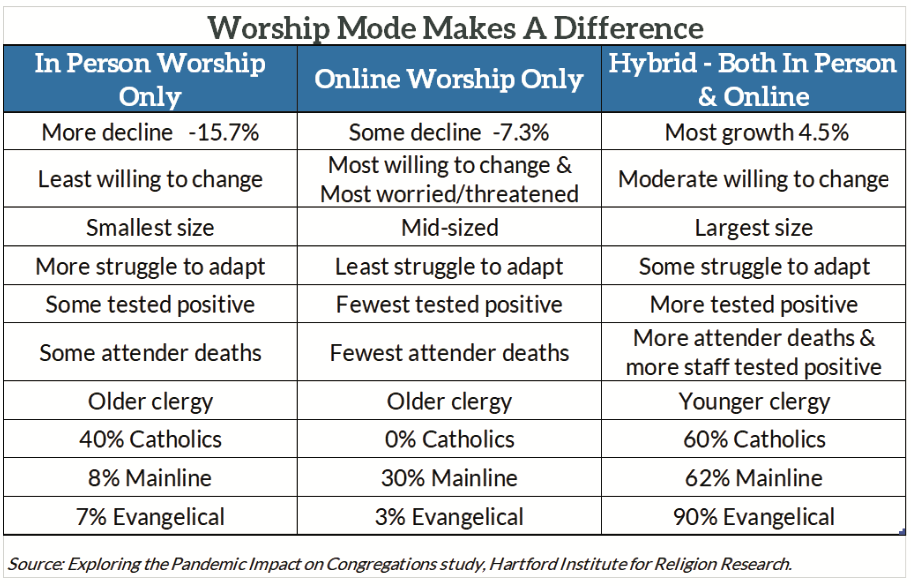

As for worship attendance, the survey found that 93 percent of congregations had resumed worship by 2021, but mostly in some hybrid form. As might be expected, the decline in worship attendance from 2019 was greater than previous years, standing at 12 percent. By contrast, the pre-pandemic 2020 Faith Communities Today survey had found a five-year median attendance decline of 7 percent for all U.S. congregations. In this pattern of decline it mattered how worship was conducted: the 15 percent of congregations who reported only meeting in person (smaller congregations with older clergy but also almost half of Orthodox and Catholic churches) also reported the steepest decline, at 15.7 percent. For the 5 percent of congregations who remained completely online, the decline was 7.3 percent. These are the congregations most concerned about the pandemic and represented 30 percent of mainline churches, but very few evangelical and no Catholic or Orthodox ones. For the 80 percent of congregations maintaining a hybrid mode of worship, there was an overall growth of 4.5 percent in attendance. These congregations also reported the highest rates of mortality from the virus, and are represented by 90 percent of all evangelical churches, 60 percent of Catholic and Orthodox parishes, and 62 percent of mainline congregations.
(The Hartford Institute report on Covid and congregations can be downloaded from: https:// www.covidreligionresearch.org)

The authors claim that no switch from Christian religion to holistic spirituality can be observed, in contrast with common assumptions. Except for the practice of yoga, which has been rising over the past decade, several other practices or beliefs associated with holistic spiritual orientations have either remained stable or declined. But this pattern does not hold for all generations, with holistic spirituality being most strongly represented among people born between 1951 and 1970 (with the exception again of yoga and its rising spread among people born since 1981). Research data seems to confirm the impact of secularizing factors on religious socialization. There is also a decline in individual religiosity and religious affiliation over time. Neither believing nor belonging is on the increase, with time-demanding religious behavior (i.e., attendance) being given up first. One can thus speak of “generations with decreasing faith.”
A similar failure of transmission is taking place in eastern and western Germany, according to a paper Stolz, together with Oliver Lipps and David Voas, presented at the recent meeting of the Society for the Scientific Study of Religion in Portland, Ore., which RW attended. Using data from the German Socio-Economic Panel, the researchers looked at children’s and parents’ levels of religiosity over time. They found that a failure of religious socialization created the same pattern of cohort replacement evident in other parts of Europe, with each generation becoming less religious over time. They unexpectedly found that religious transmission took place to a greater extent in highly secularized east Germany than in west Germany, most likely due to a minority of very religious parents being more able to pass on their faith there. They found that those in stricter religions were better able to pass on their faith that those in more lax ones (such as evangelicals as compared to mainline Protestant and Catholic families). But Stolz, Lipps, and Voas were less certain about the factors driving this cohort replacement, speculating that it may be due to the social context where religion is not seen as important more than to individual attributes.
(The paper on the Swiss research is a summary of a longer article to be published in 2022. The paper can be downloaded in German or in French from the website https:// www.socialchangeswitzerland.ch)

